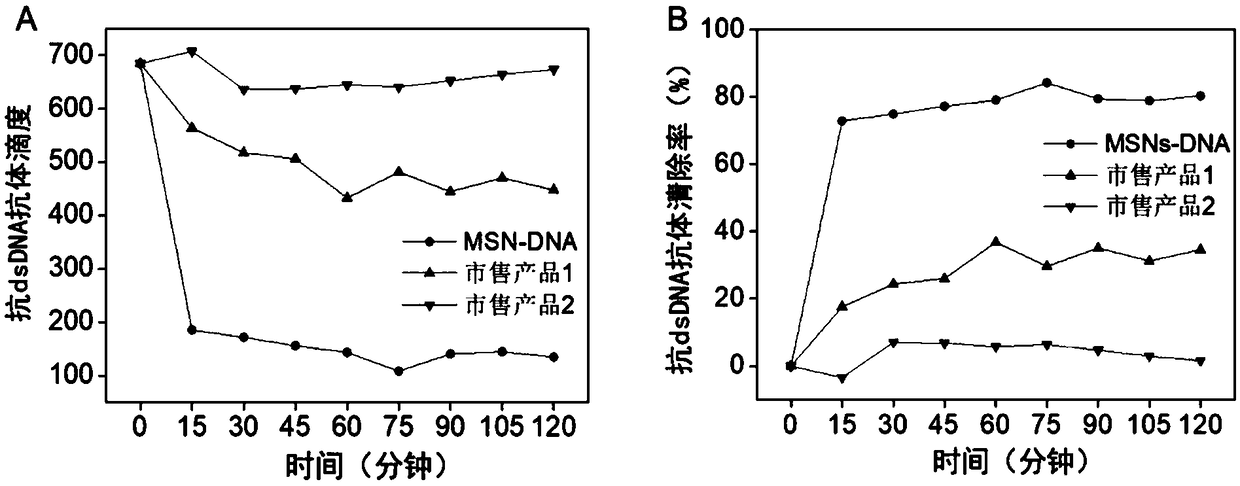Application of silicon dioxide nanoparticles to DNA (deoxyribonucleic acid) immunoadsorbent
An immunoadsorbent and nanoparticle technology, which is applied in the direction of selective adsorption, inorganic chemistry, ion exchange, etc., can solve the problems of DNA immobilized capacity decrease, shedding, insufficient embedding, etc.
- Summary
- Abstract
- Description
- Claims
- Application Information
AI Technical Summary
Problems solved by technology
Method used
Image
Examples
Embodiment 1D
[0123] Preparation of Example 1DNA-MSNs Nanoparticles
[0124] (1) Ultrasonically disperse 4.0 g of cetyltrimethylammonium chloride (Aladdin Company) in 40 mL of water, add 106.8 mL of triethylamine (Aladdin Company) dropwise, stir for 1 hour, and add 3 mL of orthosilicon dropwise Acetate ethyl ester (Aladdin Company), stirred and refluxed at 90°C for 2h. After the reaction was completed, the samples were collected and centrifuged at 12000 rpm to obtain mesoporous silica nanoparticles.
[0125] (2) The mesoporous silica nanoparticles were washed three times with ethanol and ultrapure water respectively, dried in an oven at 60°C, ground into powder, and calcined in a muffle furnace at 550°C for 5 hours.
[0126] (3) Take 100 mg of mesoporous silica nanoparticles treated in step (2) and disperse them in 20 mL of toluene, add 2 mL of 3-aminopropyltriethoxysilane (Aladdin Company), stir for 30 min, heat up to 110 ° C and reflux Centrifuge at 12,000 rpm for 24 hours to obtain a w...
Embodiment 2D
[0129] Example 2 DNA-SiO 2 Preparation of nanoparticles
[0130] (1) Mix and stir 142.8mL ethanol, 20mL water and 3.14mL ammonia solution for 10min, then slowly add 6mL tetraethyl silicate (Aladdin Company), stir and react for 2h, centrifuge at 12000rpm, wash with water and ethanol three times respectively , freeze-dried to obtain solid silica nanoparticles.
[0131] (2) Disperse 100mg of solid silica nanoparticles in 20mL of toluene, add 2mL of 3-aminopropyltriethoxysilane (Aladdin Company), stir for 30min, heat up to 110°C and reflux for 24h, centrifuge at 12000rpm, wash with ethanol Wash with water three times respectively to obtain solid silica nanoparticles with amino groups on the surface.
[0132] (3) Disperse 100 mg of solid silica nanoparticles containing amino groups on the surface obtained in step (2) with ethanol, then add 400 mg of succinic anhydride (Aladdin) dispersed with ethanol, stir for 5 h at 37 ° C, and centrifuge at 12000 rpm , washed three times with ...
Embodiment 3A
[0134] Preparation of embodiment 3AS1411-MSNs nanoparticles
[0135] Take 50 mg of carboxyl-modified mesoporous silica nanoparticles (MSNs-COOH) obtained in step (4) of Example 1 and disperse them uniformly in 15 mL of water, and add 10 mg / mL N-hydroxysuccinimide (NHS, Aladdin Company) and 1-(3-dimethylaminopropyl)-3-ethylcarbodiimide hydrochloride (EDC, Aladdin Company) each 2mL, stirred at room temperature for 2h, added Tris-HCl solution (0.05M , pH=8.0) dissolved AS1411 nucleic acid aptamer (purchased from Sigma, USA, nucleotide sequence shown in SEQ ID NO:1) solution (concentration is 2.5mg / mL, adding amount is 1mL), stirred at room temperature for 24h , centrifuged at 12000rpm, washed with water three times, freeze-dried, and ground to powder to obtain AS1411-MSNs nanoparticles.
PUM
 Login to View More
Login to View More Abstract
Description
Claims
Application Information
 Login to View More
Login to View More - R&D
- Intellectual Property
- Life Sciences
- Materials
- Tech Scout
- Unparalleled Data Quality
- Higher Quality Content
- 60% Fewer Hallucinations
Browse by: Latest US Patents, China's latest patents, Technical Efficacy Thesaurus, Application Domain, Technology Topic, Popular Technical Reports.
© 2025 PatSnap. All rights reserved.Legal|Privacy policy|Modern Slavery Act Transparency Statement|Sitemap|About US| Contact US: help@patsnap.com



